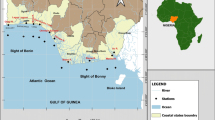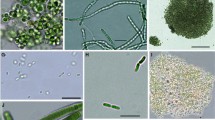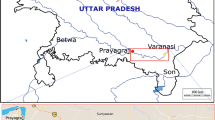Abstract
Aguelmam Azizgza (LAZ) and Dayet Afourgah (DAF) are two Moroccan natural lakes located in a humid hydrographic basin of the Middle Atlas Mountains. Both are considered important reservoirs of plant and animal biodiversity. In addition, they are extensively used for recreational and fishing activities and as a water source for irrigation of agricultural crops. Recurrent cyanobacteria scum episodes in the two water bodies have been reported, Microcystis being the main genus in the scums. Here, we report on the toxic potential of three Microcystis aeruginosa strains isolated from those lakes: Mic LAZ and Mic B7 from LAZ and Mic DAF isolated from DAF. The toxic potential was checked by their microcystin (MC) content and the presence of mcy genes involved in MC synthesis. The identification and quantification of MC variants were performed by high-performance liquid chromatography-photo-diode array. The detection of mcy genes was achieved by whole-cell multiplex PCR that allowed the simultaneous amplification of DNA sequences corresponding to specific mcy regions. MC content of cultured cells, as MC-LR equivalents per gram cell biomass, was slightly higher in Mic LAZ (ca. 860) than in Mic B7 (ca. 700) and Mic DAF (ca. 690). Four MC variants were identified in the three isolates: MC-WR, MC-RR, MC-DM-WR, and MC-YR. The presence of toxic Microcystis strains in the two studied lakes may be regarded as an environmental and health hazard, especially during periods of bloom proliferation. It would be recommended the use of two complementary techniques, as those utilized herein (HPLC and mcy detection) to alert on highly probable toxicity of such lakes.



Similar content being viewed by others
References
Ansari, M. Z., Yadav, G., Gokhale, R. S., & Mohanty, D. (2004). NRPS-PKS: a knowledge-based resource for analysis of NRPS/PKS megasynthases. Nucleic Acids Research, 32(Web Server issue), W405–W413.
Baker, J. A., Entsch, B., Neilan, B. A., & McKay, D. B. (2002). Monitoring changing toxigenicity of a cyanobacterial bloom by molecular methods. Applied Environmental Microbiology, 68, 6070–6076.
Barón-Sola, Á., Ouahid, Y., & del Campo, F. F. (2012). Detection of potentially producing cylindrospermopsin and microcystin strains in mixed populations of cyanobacteria by simultaneous amplification of cylindrospermopsin and microcystin gene regions. Ecotoxicology and Environmental Safety, 75, 102–108.
Böttcher, G., Chorus, I., Ewald, S., Hintze, T., & Walz, N. (2001). Light-limited growth and microcystin content of Planktotrix agardhii and Microcystis aeruginosa in turbidostats. In I. Chorus (Ed.), Cyanotoxins—occurrence, effects, controlling factors (pp. 115–133). Heidelberg: Springer.
Chorus, I. (2001). Cyanotoxins: occurrence, causes, consequences. Berlin: Springer. 357 pp.
Chorus, I., & Bartram, J. (1999). Toxic cyanobacteria in water. A guide to their public health consequences, monitoring and managements. WHO, London: E. & F. N. Spon, Routledge. 400 pp.
Codd, G. A., Morrison, L. F., & Metcalf, J. S. (2005). Cyanobacterial toxins: risk management for health protection. Toxicology and Applied Pharmacology, 203, 264–272.
Corbel, S., Mougin, C., & Bouaïcha, N. (2014). Cyanobacterial toxins: modes of actions, fate in aquatic and soil ecosystems, phytotoxicity and bioaccumulation in agricultural crops. Chemosphere, 96, 1–15.
Cuvin-Aralar, M. L., Fastner, J., Focken, U., Becker, K., & Aralar, E. V. (2002). Microcystins in natural blooms and laboratory cultured Microcystis aeruginosa from Laguna de Bay, Philippines. Systematic and Applied Microbiology, 25, 179–182.
De Figueiredo, D. R., Azeiteiro, U. M., Esteves, S. M., Gonçalves, F. J. M., & Pereira, M. J. (2004). Microcystin-producing blooms—a serious global public health issue. Ecotoxicology and Environmental Safety, 59, 151–163.
Del Campo, F. F., & Ouahid, Y. (2010). Identification of microcystins from three collection strains of Microcystis aeruginosa. Environmental Pollution., 158, 2906–2914.
Dittmann, E., Neilan, B. A., & Börner, T. (2001). Molecular biology of peptide and polyketide biosíntesis in cyanobacteria. Applied Microbiology and Biotechnology, 57, 467–473.
Douma, M., Loudiki, M., Oudra, B., Mouhri, K., Ouahid, Y., & del Campo, F. F. (2009). Taxonomic diversity and toxicological assessment of cyanobacteria in Moroccan inland waters. Journal of Water Science, 22, 435–449.
Douma, M., Ouahid, Y., del Campo, F. F., Loudiki, M., Mouhri, K., & Oudra, B. (2010). Identification and quantification of cyanobacterial toxins (microcystins) in two Moroccan drinking-water reservoirs (Mansour Eddahbi, Almassira). Environmental Monitoring and Assessment, 160, 439–450.
Douma, M., Manaut, N., Oudra, B., & Loudiki, M. (2016). First report of cyanobacterial diversity and microcystins in a Microcystis strain from a Mediterranean coastal lagoon (Sidi Boughaba, Morocco). African Journal of Aquatic Science, 4, xxx-xxx. doi:10.2989/16085914.2016.1252309 (in press).
Fastner, J., Erhard, M., Carmichael, W. W., Sun, F., Rinehart, K. L., Ronicke, H., & Chorus, I. (1999). Characterization and diversity of microcystins in natural blooms and strains of the genera Microcystis and Planktothrix from German freshwaters. Archiv fuer Hydrobiologie, 145(2), 147–163.
Hawkins, P. R., Novic, S., Cox, P., Neilan, B. A., Burns, B. P., Shaw, G., Wickramasinghe, W., Peerapornpisal, Y., Ruangyuttikarn, W., Itayama, T., Saitou, T., Mizuochi, M., & Inamori, Y. (2005). A review of analytical methods for assessing the public health risk from microcystin in the aquatic environment. Journal of Water Supply: Research & Technology–Aqua, 54, 509–518.
Hernández, E., & Olguín, E. J. (2002). Biosorption of heavy metals influenced by the chemical composition of Spirulina sp. (Arthrospira) biomass. Environmental Technology, 23, 1369–1377.
Hesse, K., & Kohl, J. G. (2001). Effects of light and nutrient supply on growth and microcystin content of different strains of Microcystis aeruginosa. In I. Chorus (Ed.), Cyanotoxins—occurrence, effects, controlling factors (pp. 104–115). Heidelberg: Springer.
Komarek, J., & Anagnostidis, K. (1999). Cyanoprokaryota. 1. Teil: Chroococcales. Süßwasserflora von Mitteleuropa. Berlin: Spectrum Akademischer verlag, Gustav Fischer.
Koreivienė, J., Anne, O., Kasperovičienè, J., & Burškytė, V. (2014). Cyanotoxin management and human health risk mitigation in recreational waters. Environmental Monitoring and Assessment, 186, 4443–4459.
Kotai J. (1972). Instructions for preparation of modified nutrient solution Z8 for algae. Oslo: Norwegian Institute for Water Research Publication B-11/69, Blindem.
Kurmayer, R., Dittman, E., Fastner, J., & Chorus, I. (2002). Diversity of microcystin genes within a population of the toxic cyanobacterium Microcystis spp. in lake Wannsee (Berlin, Germany). Microbial Ecology, 43, 107–118.
Loudiki, M., Oudra, B., Sabour, B., Sbiyyaa, B., & Vasconcelos, V. (2002). Taxonomy and geographic distribution of potential toxic cyanobacterial strains in Morocco. Annales de Limnologie, 38, 101–108.
Mankiewicz-Boczek, J., Izydorczyk, K., Romanowska-Duda, Z., Jurczak, T., Stefaniak, K., & Kokocinski, M. (2006). Detection and monitoring toxigenicity of cyanobacteria by application of molecular methods. Environmental Toxicology, 21, 380–387.
Mikalsen, B., Boison, G., Skulberg, O. M., Fastner, J., Davies, W., Gabrielsen, T. M., et al. (2003). Natural variation in the microcystin synthetase operon mcyABC and impact on microcystin production in Microcystis strains. Journal of Bacteriology, 185, 2774–2785.
Neilan, B. A., Dittmann, E., Rouhiainen, L., Bass, R. A., Schaub, V., Sivonen, K., & Börner, T. (1999). Nonribosomal peptide synthesis and toxigenicity of cyanobacteria. Journal of Bacteriology, 181, 4089–4097.
Niedermeyer, T. (2014). Microcystin congeners described in the literature. figshare. doi:10.6084/m9.figshare.880756.v5.
Nishizawa, T., Ueda, A., Asayama, M., Fujii, K., Harada, K., Ochi, K., et al. (2000). Polyketide synthase gene coupled to the peptide synthetase module involved in the biosynthesis of the cyclic heptapeptide microcystin. Journal of Biochemistry, 127, 779–789.
Oswald, W. J. (1988). Micro-algae and wastewater treatment. In M. A. Borowitzka & L. J. Borowitzka (Eds.), Micro-algal biotechnology (pp. 305–328). New York: Cambridge University Press.
Ouahid, Y., & del Campo, F. F. (2009). Typing of toxinogenic Microcystis from environmental samples by multiplex PCR. Applied Microbiology and Biotechnology, 85, 405–412.
Ouahid, Y., Pérez-Silva, G., & del Campo, F. F. (2005). Identification of potentially toxic environmental Microcystis by individual and multiple PCR amplification of specific microcystin synthetase gene regions. Environmental Toxicology, 20, 235–242.
Oudra, B., Loudiki, M., Sbiyyaa, B., Martins, R., Vasconcelos, V., & Namikoshi, M. (2001a). Isolation, characterization and quantification of microcystins (heptapeptideshepatotoxins) in Microcystis aeruginosa dominated bloom of LallaTakerkoust lake-reservoir (Morocco). Toxicon, 39, 1375–1381.
Oudra, B., Loudiki, M., Sabour, B., Sbiyyaa, B., & Vasconcelos, V. (2001b). Étude des blooms toxiques à cyanobactéries dans trois lacs réservoirs du Maroc: Résultats préliminaires. Revue Des Sciences De l’eau, 15, 301–313.
Oudra, B., Loudiki, M., Vasconcelos, V., Sabour, B., Sbiyyaa, B., Oufdou, K., & Mezrioui, N. (2002). Detection and quantification of microcystins from cyanobacteria strains isolated from reservoirs and ponds in Morocco. Environmental Toxicology, 17(1), 32–39.
Sabour, B., Loudiki, M., Oudra, B., Vasconcelos, V., Martins, R., Oubraim, S., & Fawzi, B. (2002). Toxicology of a Microcystis ichtyoblabe waterbloom from Lake Oued Mellah (Morocco). Environmental Toxicology, 17(1), 24–31.
Saqrane, S., & Oudra, B. (2009). CyanoHAB occurrence and water irrigation cyanotoxin contamination: ecological impacts and potential health risks. Toxins, 1, 113–122.
Sivonen, K., & Jones, G. (1999). Cyanobacterial toxins. In I. Chorus & J. Bartram (Eds.), Toxic cyanobacteria in water: a guide to their public health consequences, monitoring and management (pp. 41–111). London: E & Spon.
Starmach, K. (1966). Cyanophyta-Since Glaucophyta- glaukofity- Flora Slodkow. Polski, PWN. Warszawa.
Tillett, D., Dittmann, E., Erhard, M., von Dohren, H., Borner, T., & Neilan, B. A. (2000). Structural organization of microcystin biosynthesis in Microcystis aeruginosa PCC7806: an integrated peptide-polyketide synthetase system. Chemistry and Biology, 7, 753–764.
Valerio, E., Chambel, L., Paulino, S., Faria, N., Pereira, P., & Tenreiro, R. (2010). Multiplex PCR for detection of microcystin-producing cyanobacteria from freshwater samples. Environmental Toxicology., 25, 251–260.
Vasconcelos, V. M. (2001). Toxic freshwater cyanobacteria and their toxins in Portugal. In I. Chorus (Ed.), Cyanotoxins—occurrence, effects, controlling factors (pp. 64–69). Heidelberg: Springer.
Vezie, C., Brient, L., Sivonen, K., Betru, G., Lefeuvre, J. C., & Salkinoja-Salonen, M. (1998). Variation of microcystin content of cyanobacterial blooms and isolated strains in Lake Grand-Lieu (France). Microbial Ecology, 35, 126–135.
Whitton, B. A., & Potts, M. (2000). Introduction to the cyanobacteria. In B. A. Whitton & M. Potts (Eds.), The ecology of cyanobacteria (pp. 1–13). Dordrecht: Kluwer.
Wiegand, C., & Pflugmacher, S. (2005). Ecotoxicological effects of selected cyanobacterial secondary metabolites: a short review. Toxicology and Applied Pharmacology, 203, 201–218.
Acknowledgements
This work was funded by the Moroccan government and the Spanish Agency of International Cooperation (Bilateral Spain-Morocco Project A/011422/07 granted to FF Del Campo and B. Oudra). We acknowledge the Excellence Grant No. 03-008/2004 accorded to Douma Mountasser by the National Center of Scientific and Technical Research from the Ministry of National Education, Higher Education, Staff Training, and Scientific Research. The authors would like to thank Dr. Lee Robertson for his help in English language and critical reading of the manuscript. The useful comments of anonymous reviewers are also acknowledged.
Author information
Authors and Affiliations
Corresponding author
Additional information
Francisca F. del Campo and Brahim Oudra equally contributed to the study.
Rights and permissions
About this article
Cite this article
Douma, M., Ouahid, Y., Loudiki, M. et al. The first detection of potentially toxic Microcystis strains in two Middle Atlas Mountains natural lakes (Morocco). Environ Monit Assess 189, 39 (2017). https://doi.org/10.1007/s10661-016-5753-x
Received:
Accepted:
Published:
DOI: https://doi.org/10.1007/s10661-016-5753-x




